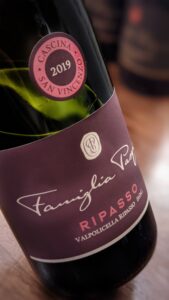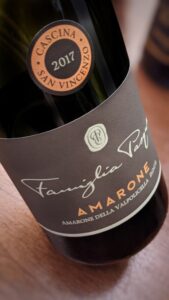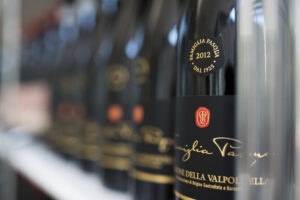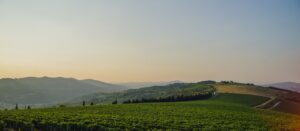The finest red wine grape bunches of the season were carefully harvested by hand by an elderly couple and their adult children as their small grandchildren watched the work that one day would be at the core of their existence. For this particular wine producing family, they took pride in hanging the grape bunches, one by one, on ropes that hung from the rafters of their barn as they believed that this was a much higher quality practice than laying the grapes out on straw mats which was the other way to induce the drying process (appassimento) to take place for the grapes that were destined for their much beloved Amarone della Valpolicella wine; at first it was a great way to achieve ripeness in the North East area of Italy, in the Valpolicella winemaking area outside of Verona, as full ripeness of grapes eluded many winemakers in that area in the past.
The dry Amarone red wine made from passito (dried) grape bunches is unique in the wide world of wine and the style of wine, which became a powerful brand for a time, gained notoriety in the early 2000s as some producers received high scores from well-known wine critics as the combination of silky texture, complex aromatics and generous flavors in the best vintages were a dynamic trio that won over many Italian wine connoisseurs. Yet the popularity of this style over-shadowed the idea of the diversity of terroirs (sense of place) in the area of Valpolicella as there are not only three different macroclimates that exists in Valpolicella but there are also many valleys running north to south that have their own sense of place and many multi-generational grape growers would even be able to speak about a greater specificity of single vineyard expression.
Through time, the process of drying the grapes has become more practical and efficient by using short plastic crates where the grape bunches are positioned in a single layer and placed into a room that has fans that create a constant circulation of air. Yet it is still extremely time consuming and demands devoted growers as the grapes need to be constantly turned and checked upon as some will have faster evaporation of water than others – some producers will actually move the crates around the rooms periodically to even out the evaporation process as some areas of the room are closer to the fans.
The one thing that hasn’t changed is the grower and producer knowledge of the diversity of sense of place throughout the Valpolicella winegrowing area yet it was never a focus of marketing as the people of Valpolicella were just happy that the style of Amarone was being appreciated. But as time has gone on, the outside world largely has had no idea of where exactly Amarone wines are made and the varying qualities of its home that bestows a particular terroir or mixtures of terroirs to each wine. But today the famous family producer Pasqua (a.k.a. Pasqua Vigneti e Cantine Spa) has taken on the mission to bring to consumers a sense of place from their beloved Valpantena section of Valpolicella, where they founded their winery almost a century ago, with a release of single vineyards in the style of Amarone as well as its sibling style Ripasso.
Organically Grown Single Vineyard
Riccardo Pasqua, family member and CEO of Pasqua Vigneti e Cantine Spa, announced that his family had not only decided to release a single vineyard in the Amarone and Ripasso style of wine but to source from a vineyard that has been organically farmed for the whole lifespan of the vines. The Amarone style is made by the crushing and fermenting of dried grapes and its sibling Ripasso (meaning “repassed”) is produced by using the lighter red Valpolicella wine, made from the same native grapes but it is made from fresh grapes, as a base to then add to the Amarone marc (the skins left over from the pressing of the Amarone dried grapes) and that Valpolicella base wine which is of “Superiore” quality continues to ferment with the marc to a richer, more complex wine called Ripasso yet not as rich or complex as the original Amarone.
The single vineyard that the Pasqua has chosen is called Cascina San Vincenzo which is located high up on a hill in the Valpantena section of the Valpolicella wine region, 985 feet high, and it is run by friends of the family that have kept it organic for 20 years – the whole lifespan of the vines. For the past 12 years the Pasqua family has worked with this plot observing over time if it was expressing a favorable distinctive sense of place that would be worth single vineyards status and Carlo Olivari, oenologist for Pasqua Vigneti e Cantine Spa, noted that there was a consistent “elegance” and “lightness” as well as “not too much muscle” that characterized this plot.
Carlo compared the 2017 Cascina San Vincenzo single vineyard Amarone with the 2017 ‘Famiglia Pasqua’ Amarone that includes a blend of a handful of vineyards from the Valpantena area, as well as comparing the two 2019 Ripasso equivalents. The Cascina San Vincenzo single vineyard Amarone and Ripasso wines had brighter aromatics with red fruit and minerality opposed to the ‘Famiglia Pasqua’ darker and earthier flavors that had a broader shoulder structure. Cascina San Vincenzo is higher in altitude than any of the vineyards used in the ‘Famiglia Pasqua’ blend as well as having a dominant component of limestone in the soil.
It is a comparison of the “soloist” versus “the orchestra” as Riccardo Pasqua explained as the multi-vineyard blend of ‘Famiglia Pasqua’ certainly benefits from the Pasqua family getting to choose the best from each plot depending on the vintage but that an excellent “soloist” such as the Cascina San Vincenzo vineyard needs to be given its own spotlight as well as bringing a stronger attention to the idea of terroir from Valpolicella vineyards.
Style Enhancing Sense of Place
As gaining a decent amount of ripeness is no longer the biggest issue in Valpolicella, although they will still be challenged by cooler vintages here and there, there has been more of a focus to shorten the drying period for the grapes of Amarone to make sure the wines are not too heavy as well as using more native grapes that bring acidity and freshness to the blend. And there has even been discussions whether the traditional practices for Amarone, which are still extremely labor intensive, make sense in modern times.
The Council for Agricultural Research and Economics (CREA), a research center that studies vineyards and winemaking as well as other agro-food chain products, has discovered evidence that suggest drying the Amarone grapes enhances a stronger sense of place. It was discovered by various tests that the main native red grape variety used in the wine, Corvina, goes through various genetic alterations during the drying process and when comparing different vineyards to each other it was the wines that came from dried grapes that had more distinct qualities linked to the sites when single vineyard wines were tasted side by side as opposed to fresh Corvina grapes that weren’t dried.
The Amarone wines in this research suggests that the drying process brings a complexity that is associated with the site that cannot be achieved without such a process and so this wine is the ultimate expression of sense of place for Valpolicella producers.
When Amarone was first gaining popularity it was during the time when wine producers were told that to find success in export markets one had to develop a brand, as brands were immediately recognizable and assured wine consumers that they were buying a trusted product and in a way just the word Amarone became a brand. Yet as information has become more accessible, there is a movement to know more about the people, the place and the culture behind the wines and to have that wine express all those elements. Whereas at one time producers, especially those in Valpolicella, were told that the outside world didn’t care so much about the terroir of their vineyards, unlike Burgundy producers in France, it was the branding of the style that mattered, but today Pasqua understands that there is an opportunity to talk about their special vineyards in Valpolicella and how their styles of wine, such as Amarone and Ripasso, enhance their precious land.
If only those grandparents who passed on their vineyards in the 1980s and 1990s could see how things have drastically changed as gaining international fans is no longer solely based on a corporate idea of a brand that was disconnected from their multi-generational vineyards as well as the stories of their sweat, blood and fierce tenacity that went into creating such wines. Today Valpolicella producers can finally talk with pride to a willing international crowd of the people, place and yes the styles of wines too; but the styles no longer take center stage but instead they are there to highlight the extraordinary vineyards and people that make these wines, Amarone and Ripasso, like no other.
***This article was originally published on Forbes: https://www.forbes.com/sites/cathrinetodd/2021/11/11/an-italian-wine-known-for-its-style-brings-focus-to-single-vineyard-sense-of-place/
The below wines were tasted during a master class at the 2021 Milano Wine Week in New York City.
Ripasso Wine Comparison

Single Vineyard
Cascina San Vincenzo Photo Credit:
Cathrine Todd
2019 Pasqua, Valpolicella Ripasso DOC, Single Vineyard Cascina San Vincenzo, Valpolicella, Veneto, Italy: 60% Corvina, 30% Corvinone and 10% Rondinella from the organic vineyard Cascina San Vincenzo in the Valpantena area of Valpolicella. This wine was singing with lifted bright red cherry aromas that were laced with minerality that had beautiful red fruit and baking spices on the palate combined with fresh acidity along the expressive finish.
2019 Pasqua, Valpolicella Ripasso DOC Superiore ‘Famiglia Pasqua’, Valpolicella, Veneto, Italy: 60% Corvina, 20% Rondinella, 10% Corvinone and 10% Negrara from the Valpantena area of Valpolicella. Dark fruit immediately on the nose that was more reserved with added notes of wet clay and dried herbs that had a lot more structure.
Amarone Wine Comparison

Cascina San Vincenzo Photo Credit:
Cathrine Todd
2017 Pasqua, Amarone della Valpolicella DOCG, Single Vineyard Cascina San Vincenzo, Valpolicella, Veneto, Italy: 60% Corvina, 30% Corvinone and 10% Rondinella from the organic vineyard Cascina San Vincenzo in the Valpantena area of Valpolicella. Fresh sage note with blackberry and ripe red strawberry on the expressive nose that had zingy cranberry notes on the palate with complex notes of forest floor and river stones that had a fine texture with a long aromatic finish.
2017 Pasqua, Amarone della Valpolicella DOCG ‘Famiglia Pasqua’, Valpolicella, Veneto, Italy: 65% Corvina, 25% Rondinella, 5% Corvinone and 5% Negrara from the Valpantena area of Valpolicella. Brooding nose with black plum and blueberry preserves with dusty earth and muscular tannins with tobacco and cigar box.













